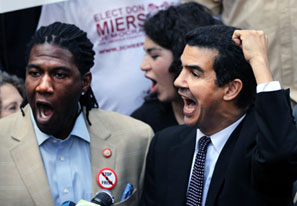
Civil disobedience historically involves a demonstration by an aggrieved people against their government. In an unusual twist, New York City is now governed by aggrieved politicians who demonstrate against the people. Standing in traffic, picketing small businesses, and interrupting their own meetings, Gotham’s elected representatives enjoy the privileges of power while simultaneously donning the mantle of the oppressed.
Last November, 15 New York city council members interrupted a meeting of the full council to protest the non-indictment of Ferguson, Missouri, police officer Darren Wilson for the shooting of unarmed teenager Michael Brown. As the presiding officer banged a gavel and lawmakers stomped out of the chamber, Council Member Andrew King read a prepared statement proclaiming that “black lives matter.” The protesting members stood in the lobby of City Hall for five minutes chanting “hands up, don’t shoot,” before heading back inside to take their seats and resume regular business. Two weeks later, following the non-indictment of NYPD officer Daniel Pantaleo for the death of Eric Garner in Staten Island, 25 council members and a contingent of supporters stood in the middle of Broadway chanting “I can’t breathe,” before staging a “die-in” in front of City Hall. Then the assemblage trooped inside, again begging “hands up, don’t shoot” to an imaginary phalanx of hostile troops, before attending their scheduled meeting.
These spectacles were widely reported as “civil disobedience,” and Mayor Bill de Blasio spoke approvingly of them as such, noting that “it’s part of our values as Americans” to protest perceived injustices. That nobody was arrested or even admonished, or that the police assigned to City Hall facilitated the disruption of a public roadway by two dozen elected officials, failed to temper the lawmakers’ sense that their actions constituted a bold strike against the powers that be. Even when elected officials in New York City do get arrested for supposed acts of civil disobedience, they are almost immediately released and face only the slightest inconvenience. Council Member and Deputy Majority Leader Jumaane Williams, a protest habitué, acknowledged as much on Twitter, noting that “pre-planned civil disobedience participant arrests don’t get processed the same” as those of ordinary civilians.
No recent example exists of a city politician spending the night in jail or otherwise suffering any of the discomforts one might expect of the truly politically committed. Council Member Brad Lander, ideological mastermind of the council’s progressive wing, was arrested in March for protesting at a car wash in Brooklyn. Lander and Council Member Carlos Menchaca, who was also arrested, were participating in a labor action by eight employees of the Vegas Auto Spa, who are suing the car wash to gain union recognition and back pay. The two council members were led away in handcuffs, smiling broadly, and were apparently released immediately. Writing on his blog, Lander noted that “a few minutes ago—in an act of civil disobedience—I was arrested . . . for standing up against the injustices happening at our neighborhood car wash.” One imagines that a typical arrestee in New York is not able within “minutes” to broadcast on social media his heroic stance against injustice.
Properly understood, civil disobedience is resistance against an authoritarian state. A powerful elected official involving himself in a labor dispute against a tiny local business scarcely rises to Gandhian levels of moral courage. In New York’s caricature of civil disobedience, politicians pretend to protest, and the police pretend to arrest them.
